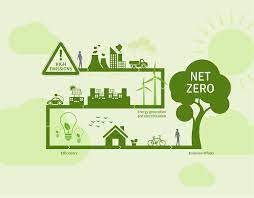According to a report titled “Competing in the new zero-carbon industrial era,” India is one of the top five economies competing to supply the world with zero-carbon technology like renewable energy and electric automobiles.
The paper was written by Linda Kalcher and Neil Makaroff of Strategic Perspectives, a pan-European think group with the goal of advancing effective climate action. China, the European Union, the United States, Japan, and India are the world’s five largest economies.
Zero-carbon technology development and application can lead to job creation, competitive advantages, and emissions reductions in important industries. These net-zero transition strategies may usher in a new industrial era distinguished by its use of carbon-free technologies.

India, China, the EU, the US, and Japan are the five economies that have a significant impact on how the world’s energy landscape is shaped and will spearhead the global adoption of net-zero technology.
The nation’s different entry position in terms of economic development, according to the research, prevents India from being compared to other economies on an equal footing. India can achieve its goals of playing a big role in the global net-zero supply chain and gaining from the transition in the near future if further investments can be acquired.
National transition plans like the European Green Deal, India’s Energy Conservation Act, China’s 14th Five-Year Plan, the US Inflation Reduction Act, and Japan’s Green Growth are some of the transition plans that are being transformed into industrial strategies.
These national transition plans might result in the creation of millions of high-quality employment, the research claims. The International Renewable Energy Agency (IRENA) predicts that by 2050, the renewable energy industry would employ roughly 40 million people. India, China, the EU, the US, and Japan are attempting to influence markets and introduce new, creative strategies by establishing themselves as global leaders in the transition to net-zero.
The net-zero transition is anticipated to not only lower all greenhouse gas emissions along the value chain, but also to improve a nation’s industrial competitiveness, economic prosperity, and energy security.
How India is attempting to move toward a net-zero economy
India is anticipated to be a model for effective net-zero development. The nation has boosted investment in the renewable energy sector and the electric vehicle industry in recent years.
The electric vehicle market is anticipated to expand at a compound annual growth rate of 49% between 2022 and 2030. By 2030, this sector is predicted to produce 50 million new employment. If the predictions come true, India will be able to quickly introduce electric two-wheelers and automobiles.
In addition to focusing on establishing goals for the development of electric cars, Assam is proposing a ban on the sale of automobiles with internal combustion engines (ICEs).
With the aid of the Faster Adoption and Manufacturing of Hybrid Electric Vehicles (FAME) Scheme, India can make progress toward the decarbonization of road transportation.
Two-wheelers are anticipated to play a significant role in the sector because China and India now hold the majority of the worldwide market for electric two-wheelers.
India will have four million two-wheeled electric vehicles by 2022. By 2024, these are anticipated to reach six million thanks to the FAME Scheme.
In the year 2022, financial flows into this switch to renewable energy technology reached unprecedented heights. For instance, spending on electrified transportation increased by double.
The rise in financing for renewable energy is, however, very meager. However, more foreign funding could expand India’s renewable energy sector.
India’s investment in the field of renewable energy
India is utilizing solar and wind energy effectively to produce electricity. India contributed 5% of the world’s electricity in 2017 from solar and wind energy. The report states that the proportion has now reached 9%.
After seeing a drop since 2017, India raised its investment in low-carbon technologies in 2021. India pledged in 2021 to grow its renewable energy capacity to 600 Gigawatts by 2032 and to meet half of its energy needs from renewable sources by 2030 during the 26th United Nations Climate Change Conference (COP26), which was held in Glasgow.
The National Solar Mission in India is a collection of legislative initiatives with the goal of expanding the use of solar photovoltaic cells there. India’s capacity for renewable energy rose four-fold between 2014 and 2022, with solar photovoltaic cells accounting for a large portion of this growth.
Instead of pursuing a more comprehensive, economy-focused strategy to enter the new industrial era, India is favoring the development of certain industries.
What G20 climate initiatives is India expected to push?
India is anticipated to press for the adoption of the global green development pact at the 18th G20 Summit. This agreement will cover climate financing, lifestyle for the environment (LiFE), accelerated progress toward the SDGs, the circular economy, energy transitions, and energy security.
India’s economy, currently the fifth largest in the world, is anticipated to grow to $3.7 trillion in 2023.
